A Survivor at Roswell: The Truth About the One that Walked Away

Don Schmitt has been one of the primary investigators of the alleged crash of a UFO in Roswell, New Mexico in 1947. He and his colleagues have tracked down hundreds of witnesses who claim to have information about what happened. When putting together the Roswell UFO crash issue of Open Minds Magazine in 2011, we asked Don to write us an article on the best evidence that an actual pilot of the alleged spacecraft survived. The following is the article he provided us for the magazine.
Ever since the Roswell crash of a flying saucer with “little men” inside, one specific rumor has persisted: that one of those “little men” actually managed to survive the ordeal. For most of the years since the 1947 Roswell crash and the subsequent weather balloon explanation, stories about mysterious bodies associated with the crash remained, but the very notion that Earth was indeed the host to a living extraterrestrial visitor was beyond the pale of belief. But, the question remained: Did an extraterrestrial survive that ill-fated night?
Eye-Witnesses’ Accounts of the Surviving Alien
Dan Dwyer
In 1947, Frankie Dwyer Rowe, a twelve-year-old girl, witnessed her father being threatened and warned by the military authorities for what he saw at the Roswell crash site. Her father, now deceased, was a crew chief for the Roswell Fire Department at the time of the incident. When the call came into the fire station that there had been an airship crash north of town, Dan Dwyer and Lee Reeves were dispatched with the station’s “tanker” (a pickup truck with a large cylindrical water tank in the back) to the crash site. The Chavez County sheriff and a couple of his deputies were also following up the rear in fast pursuit. Arriving just before the military would secure the scene, Dwyer and Reeves witnessed something totally unexpected. It wasn’t an airplane at all, but an egg-shaped vessel of some sort that they did not recognize.
And the bodies! Dwyer could see three diminutive humanoid beings lying in the lee of the craft. With his focus riveted on the craft and the bodies on the ground, Dwyer noticed a movement out of the corner of his eye. There, walking in front of him, seemingly from out of nowhere, was something right out of a science fiction novel. According to the fireman, it was about the size of a ten-year-old child, with grayish skin, no hair, and a large head and eyes. Within moments the roar of approaching vehicles could be heard as the military finally took charge of the entire affair. The two firemen were escorted away from the immediate area and warned of the consequences if they should ever speak of the incident. To further demonstrate the seriousness of what was witnessed, Dwyer and his family were paid a visit by military police that very evening at their home. Dwyer and his wife were physically threatened and were told that authorities would kill their children should they utter a word about what was witnessed earlier that day.
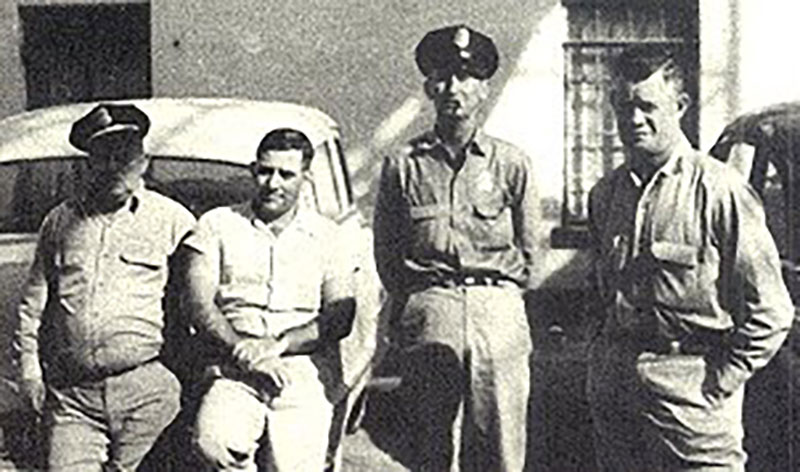
George Wilcox
The Roswell incident left an impact on all those involved, especially then-Roswell sheriff, George Wilcox. Just before Wilcox’s widow Inez passed away, she related a story to her granddaughter Barbara, who since passed on the story: “The event shocked [George]. He never wanted to be sheriff again after that. My grandmother said, ‘Don’t tell anybody. When the incident happened, the military police came to the jailhouse and told George and I that if we ever told anything about the incident, not only would we be killed, but our entire family would be killed!”’ Barbara adds, “They called my grandfather, and someone came and told him about the crash. He went out there to the site; there was a big burned area, and he saw debris. There were four space beings. Their heads were large. They wore suits like silk. One of the ‘little men’ was alive.” Inez Wilcox reiterated to Barbara that her and George took the threats very seriously and kept the information from the family.
Sergeant Homer G. Rowlette

Sergeant Homer G. Rowlette, Jr., was a member of the 603rd Air Engineering Squadron at the RAAF in 1947. He was a career military man and retired as an NCO after twenty-six years of dedicated service to his country. Before passing away in March 1988, he finally conveyed to his son, Larry the following startling information about his involvement with the “crash of the flying saucer.” Rowlette was part of a cleanup detail sent to the crash site north of Roswell. Larry was told that his father had seen everything. He handled the “memory material,” which according to Homer, was “thin foil that kept its shape.” If that wasn’t enough, he described the actual ship, which was “somewhat circular.” He also caught his son completely by surprise when he announced, “I saw three little people. They had large heads and at least one was alive!”
Master Sergeant Harry Telesco
Corroboration of Rowlette’s story has come from another member of the same squadron also stationed at Roswell at that time. Master Sergeant Harry Telesco had already passed away, when I located and contacted his family in 2007. According to his daughter, her late father had spoken many years ago of being at the crash site north of town and seeing the strange wreckage and little bodies there. He also testified that he had seen one that was still alive.
Richard Loveridge
In 1947, Richard Loveridge worked as a mechanical engineer for the Boeing Aircraft Company and was part of their crash-investigation team. When information came in about the crash of an aircraft outside of Roswell, Loveridge drove to the area believing it was one of their planes. It would not be until the last year of his life in 1993 that he would finally confess to his family about the true nature of the alleged “plane” crash. The Boeing crash investigator admitted that he “saw everything.” He saw the wreckage, which was not from a conventional aircraft, as well as three small, deceased “entities” and one that was still alive. Loveridge described them as “child-size” and “grayish” in color. He refused to elaborate any further to his family: “Don’t ask me any more about this. They can hurt you.”
Ervin Boyd
Ervin Boyd worked as a B-29 mechanic at the Roswell Army Airfield (RAAF) in 1947; he worked specifically in Hangar P3, which would later be known as Building 84. On the particular day in question, Boyd was taking a cigarette break on what he called a “hot summer day,” and the doors of the hangar were open on both ends of the building. As soon as he stepped outside the hangar doors, he observed a number of men and vehicles swarming towards the building. Startled by the situation, he quickly noticed that some of the men were carrying what he first thought was the body of a child. “Why didn’t they take it to the hospital?” he asked himself. As they passed by him, he was shocked to see that it was something else.
“It was child-size, four feet, maybe a little more, and a head that was larger than one on a normal body. The eyes were walnut-shaped and also larger than normal. From my angle, it didn’t look like it had much of a nose. The arms were a bit longer too, and the skin was ashy, gray and kind of scaly. I believe it was still alive.”
Suddenly, a number of officers grabbed Boyd and rushed him away from the area and started to get physically rough with him. One of them sternly stated, “Mr. Boyd, you didn’t see anything.” But, the civilian persisted. Finally, he was warned that if he ever said one more word, not only would he lose his job, but the lives of his wife and children would be at stake. It would not be until he suffered a stroke twenty-four years later that he would finally break his silence with his family.
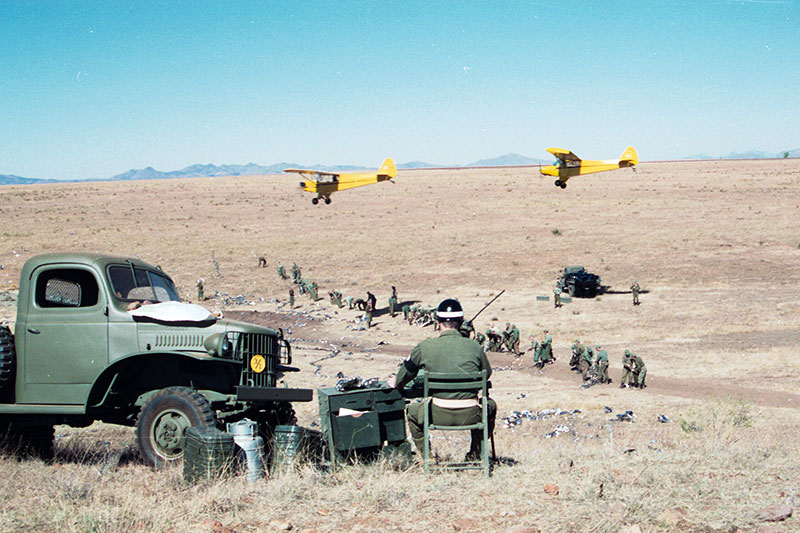
Joseph Montoya
That same afternoon, Monday, July 7, 1947, New Mexico’s newly elected thirty-two-year-old lieutenant governor, Joseph Montoya, was in Roswell. It is not entirely clear how the politician came to be on the base at the RAAF on the exact day as some of the bodies, including the possible survivor from the crash. One possible scenario is that he was there on Independence Day weekend for the dedication of a new plane, and after the ceremony he was escorted over to the B-29 hangar just as the first military vehicles were bearing down with their “out-of-this-world” cargo.
Montoya would confide to close associates that he had seen “four little men.” He described how small they were, along with the stunning fact that “one was alive!” Montoya painted the beings as, “short, only coming up to my chest. [They were] skinny with big eyes shaped like tear-drops. [The] mouth was real small, like a knife-cut across a piece of wood, and they had large heads.”
Next, he described the scene inside the hangar. Each of the little men, including the one that was alive, was stretched out on a table brought over from the mess hall and set up for that purpose. “I knew that one was alive because I could hear it moaning.” Montoya said that it was moving, with its knee bent and rocking back and forth
After a frantic exit from the hangar, Montoya was picked up and driven from the base by associates. Montoya would always warn that “It’s too dangerous to talk about.” Even years later, he would continue to caution that “the government will get you.”
“Eli” Benjamin

Another man who himself admits to having seen bodies was Elias “Eli” Benjamin (a pseudonym). His wife told me much about the incident, but it would be several years before Eli would tell me himself. As a retired career U.S. Air Force man, Benjamin feared for his pension—and still does—if he ever talked about Roswell. Benjamin and his wife had come to the International UFO Museum and Research Center in Roswell in 2002 to see the exhibits. Against her husband’s wishes, Mrs. Benjamin stopped into the museum director’s office to tell someone about her husband. After hearing Mrs. Benjamin’s story, especially the part about bodies and the hospital, Julie Shuster, the museum director, felt that a private interview with Mr. Benjamin was warranted. It was soon apparent, however, that there was a major problem: Mr. Benjamin was nowhere to be found. He had left the building, when he observed his wife and the director looking around for him—he was a reluctant witness, to put it mildly.
Since that day, I have managed to track down the former member of the 390th Air Service Squadron and meet with him half a dozen times to try to gain his confidence. In the process, I learned that Benjamin’s main fear, similar to so many others who were and are reluctant Roswell witnesses, was his belief that he, as a retired air force veteran, might lose his pension if he said anything about those long-ago events. I assured Benjamin that I knew of no instances whatsoever of someone losing his pension for talking about Roswell. Besides, the secretary of the air force issued a proclamation in 1994 that absolved anyone with knowledge about the Roswell incident who believed that they were still subject to security or secrecy oaths regarding the matter. The other thing I noticed was that Benjamin was still deeply moved, if not troubled, by what he witnessed back in 1947, and he broke down in tears on several occasions when talking to me about it. His wife also revealed that her husband still has trouble sleeping comfortably and continued to wake up suddenly in the middle of the night, shaking. In 2005, the eighty-year-old Eli Benjamin agreed to tell his story.
In July 1947, Eli Benjamin was a private first class with the 390th Air Service Squadron at the Roswell Army Air Field. Possessing a top secret clearance, Private First Class Benjamin was authorized to provide security support for the most highly classified operations of the 509th Bomb Group—the first atomic-bomb wing in the world. In addition to his primary job of guarding the B-29 Bombers, one of his secondary duties was that of a recovery specialist, which involved the grim activities associated with the aftermath of plane crashes.
On the morning of Monday, July 7, 1947, Benjamin walked back to his barracks after a night of guard duty on the flight line followed by breakfast at mess hall. “Something’s going on” he thought to himself, as he stood at attention and saluted the playing of the national anthem and morning flag-raising ritual at the base headquarters on the south end of the esplanade. He knew that the base commander, Colonel William Blanchard, normally held his weekly staff meetings on Tuesday mornings, but on this day, Benjamin thought there were too many staff cars and other vehicles parked in the headquarters parking lot for a regular staff meeting. When Benjamin finally arrived back at his barracks, “Word was given to my squadron to be on the alert for special duty,” he said. Such was life in the 509th and the Strategic Air Command and sleep after his long shift would have to remain a secondary consideration. The word finally found Benjamin: “Benjamin! Get your gun and report to hangar P-3 for guard duty.”
Upon arriving at the B-29 hangar to report to the officer in charge, Benjamin walked into a commotion at the main entrance of the building. A number of military police were trying to restrain the very officer from whom Benjamin was supposed to get his duty instructions. The lieutenant colonel was clearly experiencing an emotional reaction to the situation at hand, which seemed to be the transfer of a number of gurneys over to the base hospital. Another officer quickly pointed to Benjamin and ordered him to complete the assignment.
While in the process, something under one of the sheets covering each litter appeared to be moving. Then, as each of the stretchers was loaded into the back of a waiting ambulance truck, a sheet fell away revealing the grayish face and swollen, hairless head that clearly was not human.
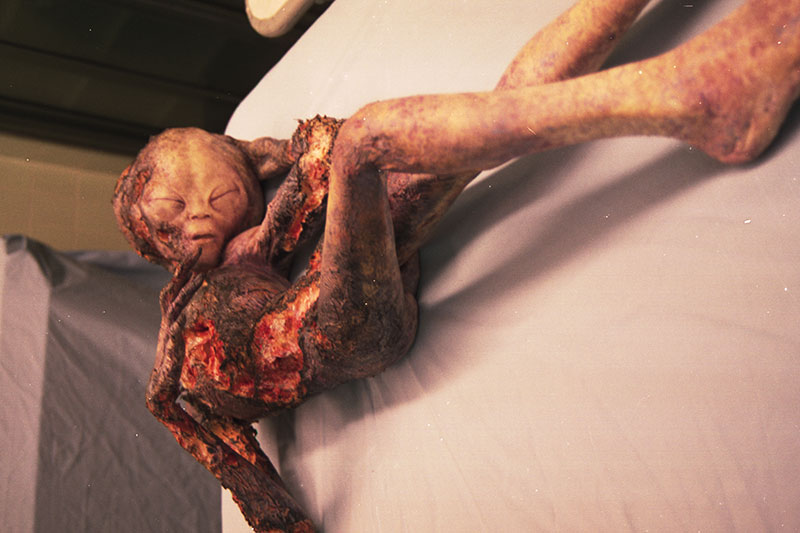
The military police orders were to deliver the cargo to the base hospital emergency room (Building 317) and remain there until relieved. Once at the medical facility, a half-dozen hospital personnel and men in suits took control of one specific gurney. All eyes were on the covered arrival as they removed the sheet from a being with an over-sized head, which had large, slanted eyes, two holes in place of a nose, and a slit for a mouth. For a number of moments all surrounding the patient just stood staring with mouths agape. It was alive. As the last of the gurneys was wheeled in, Benjamin and the other military police were immediately dismissed, sent back to their squadrons, and sworn to secrecy. They were told the incident never happened.
Sixty-three years after the event, the fog of time prevents Eli Benjamin from recalling the names or faces of the other men assigned to “escort duty” that day. They may well have been from other squadrons on the base or even from other bases brought in from outside (known as augmentation troops) to prevent the comparing of notes later on.
For her part, Mrs. Benjamin confirms her husband’s account of his involvement in the Roswell events of July 1947. She further states that he confided the story to her with the promise that she would never tell anyone else. Eli’s memories of that night—seeing the swollen face and slanted eyes of the “species”—remain with, and haunt, him to this day.
Roy Musser
Roy Musser happened to be at the base that afternoon. He was a civilian contractor painting part of the hospital. Working in the rear, where the loading dock area was located, he claimed to have seen the arrival of the small bodies and the “creature.” Apparently uninjured, he observed it walking and said it looked like a “very slender child.”
The military warned Musser that he was never to mention what he had seen to anyone or he and his family would be in jeopardy. Musser kept quiet for a number of years before relating the experience to fireman Dan Dwyer.
Miriam “Andrea” Bush
All military hospital administrators had their own secretary. In the case of Lieutenant Colonel Harold M. Warne, his was a twenty-seven-year-old civilian woman named Miriam “Andrea” Bush. Miriam was a graduate of New Mexico State College at Las Cruces, where she had majored in business administration. She also had a top security job at the base hospital. But none of her prior experiences prepared her for what she was about to see.
As she was performing routine duties at the hospital, Dr. Warne took her by the arm and quietly mentioned that she should accompany him to the examination room. Upon entering, she was immediately surprised to observe a number of bodies on gurneys in the middle of the room. At first she thought they were children based on their size. Their skin was grayish to brown in tone, and white linens covered most of each body. But the heads were too large to be children and had large staring eyes. All at once, one of them moved. Miriam would never forget what she had seen that day in Roswell.
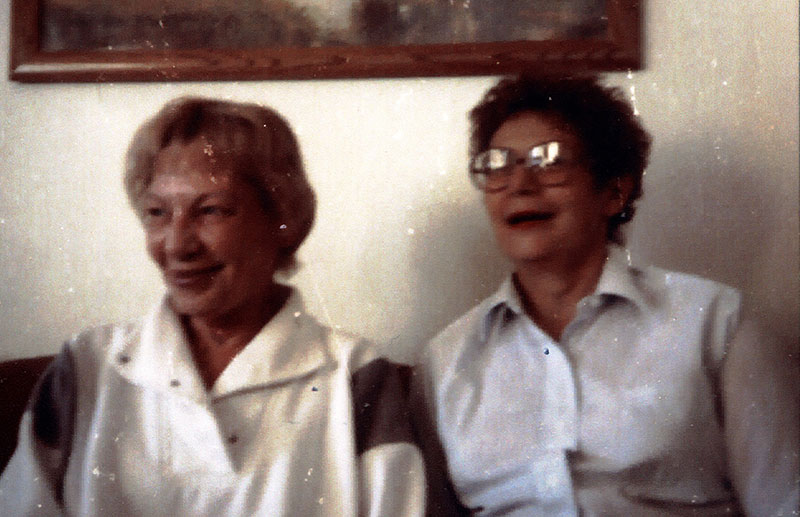
What Became of the Surviving Alien?
To date there remains no eyewitness testimony as to what ultimately became of the survivor and how it was transported from Roswell. There is reliable information, however, that the being did spend some time at Wright Patterson Air Force Base and was still there up to nine months later in 1948.
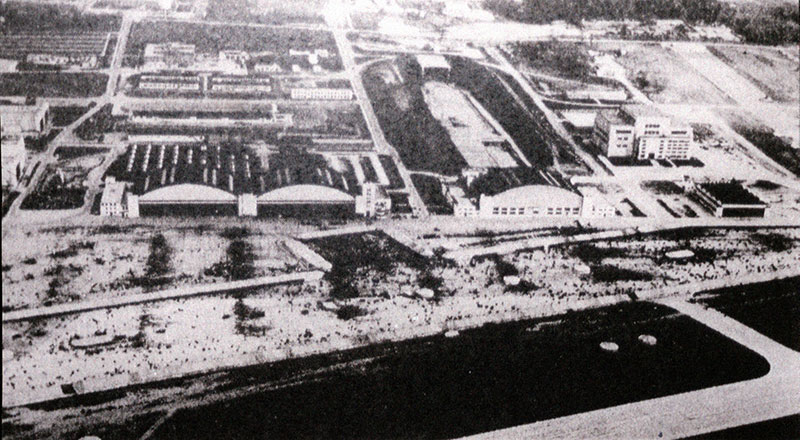
While on his deathbed in 1997, Lieutenant Colonel Marion Magruder, a highly decorated World War II flying ace, swore to his five sons that, while with the War College, he was assigned to Wright Patterson Air Force Base in April 1948 and allowed to briefly see the “live alien” at that time. He and the others in his company were instructed that the being was recovered from the crash in Roswell just the year before. His description was similar to all the other eye-witnesses. He emphasized that there was no question that it “came from another planet.”
As one of the personnel at the RAAF once remarked, “They sure weren’t from Texas.” And in the same vein, they weren’t from Japan, Germany, or anywhere else on Earth. That is one issue all of the witnesses remain unanimous on.




So there is a planet with the same atmosfphere as our Earth, nice.
Rev 12 predicts the whole upper dimension will be purged of these little devils. They will be forced down to the earth. I wonder how the militaries of the world will handle that? These are not friendly wise Vulcans making first contact by the way. These monsters are Gen 6 hybrids & their managers who will destroy the earth & everyone in it if possible. Yikes.
Well interesting story, and descriptions being consistent with different people tends to suggest credibility.
I’m a fence sitter as have not experienced anything difinitive myself.
Although saw a UFO fly low over the trees and the highway I was driving on.
UFO had a red light one side green the other, in between so many brightwhite lights it made it impossible to see the shape of the object.
The reason earthlings do not share actual events is because of these brainless comments. After 47 years of both investigations and endless research I can clearly state the following. Only 3% of the earths population are able to see. The other 97% are walking around within a square mind syndrome. What a waste, I actually feel pity for these creatures.
I lived in Roswell for 15 years. I have met the children of eye witnesses and direct witnesses of other “encounters”. I believe the accounts to be fact because none of the witnesses get fame and fortune; instead they get grief and hardship for telling the truth. So nothing is “in it for them.”
Dear Mr Schmitt,
My name is Matthew Illsley and I’m an amateur ufologist from Mansfield, England. Over the last couple of years, I worked with Dr David Clarke to locate and publicise the Calvine UFO photo.
The reason for me contacting you is that there exist online snippets of a video interview which I believe you and Stanton Friedman made in 1990 with Brigadier General Thomas DuBose in relation to the latter’s knowledge of Roswell. The Twitter-based UFOB team (ufob.space@gmail.com) and I were hence wondering whether (a) the full video of the interview still exists, and, if it does, (b) whether you would be able to share it with us and/or online, please.
Thank you very much for your consideration and I look forward to hearing from you.
Kindest regards,
Matthew Illsley
@illsleymatthew on Twitter